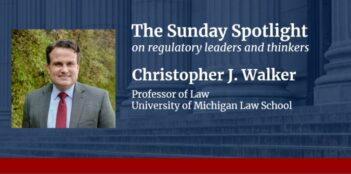
Scholar argues for regulatory reforms grounded in an intense focus on net benefits.
Consider two hypothetical courses of action that an administrative agency could take. In option one, the agency can issue a new regulation that costs $100 million and would result in $300 million worth of benefits. Mindful of costs, the agency also repeals two existing regulations, each costing $50 million and resulting in $200 million worth of benefits. In option two, the agency can issue a new regulation that costs $200 million and would result in $700 million of benefits, but it will not repeal any existing regulations.
A quick computation reveals that option one results in a $100 million net loss of benefits and option two results in a $500 net gain of benefits. Yet according to an executive order issued by President Donald Trump as one of the first steps in his touted deregulatory agenda, administrative agencies are forbidden from selecting option two.
In a recent paper, Cass Sunstein, the Robert Walmsley University Professor at Harvard Law School, argues there is no reason that an agency should be allowed to pursue option one, but not two. Sunstein claims that the administrative state, as of late, systematically neglects the benefits of regulation, instead choosing to obsess over regulatory costs. For that reason, Sunstein advocates a series of regulatory reforms make room for the legitimate goal of seeking to reduce regulatory costs—just not at the expense of substantial net benefits.
Most of the problem, according to Sunstein, stems from Executive Order 13,771. In 2017, President Trump issued what became known as the “one in, two out” order, requiring that “any new incremental costs associated with new regulations shall, to the extent permitted by law, be offset by the elimination of existing costs associated with at least two prior regulations.” Furthermore, the order mandated that the total cost of all new regulations finalized in a year cannot be greater than zero— a policy which Sunstein refers to as a “regulatory budget.”
An effort to reduce the costs of regulation, however, is not by itself problematic, says Sunstein. Instead, the problem with the executive order stems from its failure to require any consideration of the net benefits of the regulation an agency is seeking to implement and the two it is seeking to eliminate.
In theory, an agency would be in compliance with the order even if the net benefits of the regulation “coming in” are entirely offset by the reduction in net benefits from the two regulations “going out.” In fact, drawing from the Office of Information and Regulatory Affairs’s (OIRA) annual reports, Sunstein highlights that although regulatory costs dropped significantly, net benefits drastically declined from an estimated $24.7 billion in 2016 to approximately $0.3 billion in 2018.
The systematic neglect of regulatory benefits perpetuated by Executive Order 13,771, as evidenced by OIRA’s annual reports, leads Sunstein to the conclusion that regulatory budgets and “one in, two out” rules do not make any sense, even if cost reduction is itself a legitimate goal. Instead, he advocates “cost-benefit discipline, with an intense focus on net benefits” before issuing new regulations, in addition to retrospective review of regulations already in effect to eliminate costs imposed by regulations that are no longer net beneficial.
Sunstein grounds his argument for bringing consideration of benefits back into the regulatory decision-making process in three overarching goals for regulatory reform. First, measures should be implemented to take care that agencies actually regulate when regulation is justified. Second, the administrative state should stop working toward new regulations that are not net beneficial. Finally, the administrative state should periodically review existing regulations and remove those that are no longer beneficial.
In order to accomplish these goals, Sunstein posits that action from all three branches of government is necessary. First, he suggests that courts should rely more heavily on arbitrariness review of agency actions. Courts are not a useful mechanism to address agency inaction concerning an area where regulation might be highly beneficial—as only final agency actions are reviewable under the Administrative Procedure Act (APA). But courts can force agencies to reexamine benefits they may have neglected to consider during the rulemaking process.
Second, Congress could address the problem of benefit neglect by giving courts the ability to mandate agency action unless the agency can prove in a non-arbitrary manner that inaction is justified, says Sunstein. This would remedy the inability of litigants using the APA to seek judicial review of agency inaction.
Finally, Sunstein argues that Executive Order 13,771 should be repealed and replaced with an order that mandates action when the benefits justify the costs, calls for periodic retrospective reviews of existing regulations, and requires cost-benefit discipline that relies on the “best available science and economics, insulated from politics.”
A potential criticism of Sunstein’s focus on net benefits is that the goal of regulation is not always to maximize benefits without any other considerations. Sunstein acknowledges, however, that cost-benefit discipline should be subject to qualifications in instances where Congress has other intentions or for considerations of equity, dignity, and other distributional factors.



